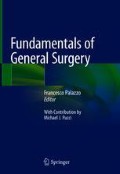Abstract
Temporary abdominal closure is a critical treatment modality in select abdominal surgery patients. Although this technique can be lifesaving and morbidity reducing, it is also associated with specific risks. These risks can be mitigated via appropriate understanding of technical treatment options while maintaining a high index of suspicion for common complications. The following chapter will review contemporary technical options inclusive of available materials and commercial devices. It will also review adjuncts of care that should reduce morbidity.
Access this chapter
Tax calculation will be finalised at checkout
Purchases are for personal use only
Suggested Readings
Rotondo MF, Schwab CW, McGonigal MD, et al. ‘Damage control’: an approach for improved survival in exsanguinating penetrating abdominal injury. J Trauma. 1993;35:375–82; discussion 382–3.
Kron IL, Harman PK, Nolan SP. The measurement of intra-abdominal pressure as a criterion for abdominal re-exploration. Ann Surg. 1984;199(1):28–30.
Wittmann DH, Aprahamian C, Bergstein JM, Edmiston CE, Frantzides CT, Quebbeman EJ, Condon RE. A burr-like device to facilitate temporary abdominal closure in planned multiple laparotomies. Eur J Surg. 1993;159(2):75.
Chiara O, Cimbanassi S, Biffl W, et al. International consensus conference on open abdomen in trauma. J Trauma. 2016;80:173–83.
Kirkpatrick AW, Roberts DJ, Faris PD, et al. Active negative pressure peritoneal therapy after abbreviated laparotomy: the intraperitoneal vacuum randomized controlled trial. Ann Surg. 2015;262(1):38–46.
References
Weber DG, Bendinelli C, Balogh ZJ. Damage control surgery for abdominal emergencies. Br J Surg. 2014;101(1):e109–18.
Kron IL, Harman PK, Nolan SP. The measurement of intra-abdominal pressure as a criterion for abdominal re-exploration. Ann Surg. 1984;199(1):28–30.
Rotondo MF, Schwab CW, McGonigal MD, et al. ‘Damage control’: an approach for improved survival in exsanguinating penetrating abdominal injury. J Trauma. 1993;35(3):375–82; discussion 382-3.
Chiara O, Cimbanassi S, Biffl W, et al. International consensus conference on open abdomen in trauma. J Trauma. 2016;80:173–83.
Joseph DK, Dutton RP, Aarabi B, Scalea TM. Decompressive laparotomy to treat intractable intracranial hypertension after traumatic brain injury. J Trauma. 2004;57(4):687–93.
Coccolini F, Montori G, Ceresoli M, et al. IROA: International Register of Open Abdomen, preliminary results. World J Emerg Surg. 2017;12:10.
Kubiak BD, Albert SP, Gatto LA, et al. Peritoneal negative pressure therapy prevents multiple organ injury in a chronic porcine sepsis and ischemia/reperfusion model. Shock. 2010;34(5):525–34.
Kirkpatrick AW, Roberts DJ, Faris PD, et al. Active negative pressure peritoneal therapy after abbreviated laparotomy: the intraperitoneal vacuum randomized controlled trial. Ann Surg. 2015;262(1):38–46.
Wittmann DH, Aprahamian C, Bergstein JM, et al. A burr-like device to facilitate temporary abdominal closure in planned multiple laparotomies. Eur J Surg. 1993;159(2):75–9.
Brock WB, Barker DE, Burns RP. Temporary closure of open abdominal wounds: the vacuum pack. Am Surg. 1995;61(1):30–5.
Demetriades D. Total management of the open abdomen. Int Wound J. 2012;9(Suppl 1):17–24.
Hourigan LA, Linfoot JA, Chung KK, et al. Loss of protein, immunoglobulins, and electrolytes in exudates from negative pressure wound therapy. Nutr Clin Pract. 2010;25(5):510–6.
Duchesne JC, Kimonis K, Marr AB, et al. Damage control resuscitation in combination with damage control laparotomy: a survival advantage. J Trauma. 2010;69(1):46–52.
Harvin JA, Mims MM, Duchesne JC, et al. Chasing 100%: the use of hypertonic saline to improve early, primary fascial closure after damage control laparotomy. J Trauma. 2013;74(2):426–30; discussion 431-2.
Burlew CC, Moore EE, Cuschieri J, et al. Who should we feed? Western Trauma Association multi-institutional study of enteral nutrition in the open abdomen after injury. J Trauma. 2012;73(6):1380–7; discussion 1387-8.
Pommerening MJ, DuBose JJ, Zielinski MD, et al. Time to first take-back operation predicts successful primary fascial closure in patients undergoing damage control laparotomy. Surgery. 2014;156(2):431–8.
Fox N, Crutchfield M, LaChant M, Ross SE, Seamon MJ. Early abdominal closure improves long-term outcomes after damage-control laparotomy. J Trauma. 2013;75(5):854–8.
Bradley MJ, DuBose JJ, Scalea TM, et al. Independent predictors of enteric fistula and abdominal sepsis after damage control laparotomy: results from the prospective AAST Open Abdomen registry. JAMA Surg. 2013;148(10):947–54.
Hatch QM, Osterhout LM, Podbielski J, et al. Impact of closure at the first take back: complication burden and potential overutilization of damage control laparotomy. J Trauma. 2011;71(6):1503–11.
Harvin JA, Kao LS, Liang MK, et al. Decreasing the use of damage control laparotomy in trauma: a quality improvement project. J Am Coll Surg. 2017;225:200. [Epub ahead of print].
Author information
Authors and Affiliations
Corresponding author
Editor information
Editors and Affiliations
Rights and permissions
Copyright information
© 2018 Springer International Publishing AG, part of Springer Nature
About this chapter
Cite this chapter
Resnick, S., Martin, N.D. (2018). Fundamentals of Temporary Abdominal Wall Closure. In: Palazzo, F. (eds) Fundamentals of General Surgery. Springer, Cham. https://doi.org/10.1007/978-3-319-75656-1_20
Download citation
DOI: https://doi.org/10.1007/978-3-319-75656-1_20
Published:
Publisher Name: Springer, Cham
Print ISBN: 978-3-319-75655-4
Online ISBN: 978-3-319-75656-1
eBook Packages: MedicineMedicine (R0)

